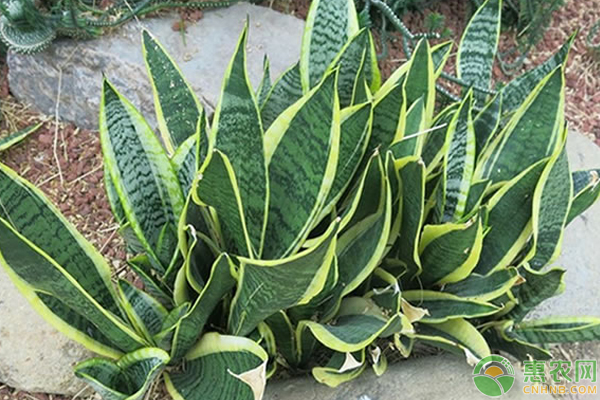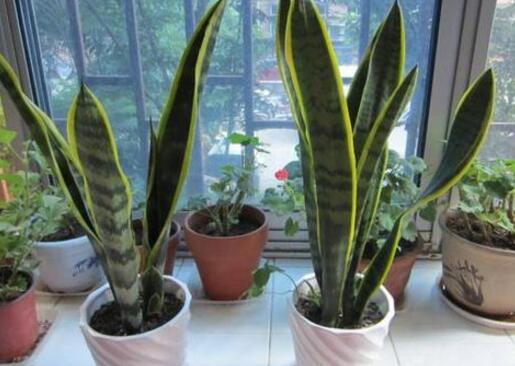How to breed and cultivate tiger orchid
Tiger skin orchid, also known as next year orchid, tiger tail orchid and so on. It is a perennial fleshy herb of the tequila family. A hundred species of flowers have a creeping rhizome and draw clusters of erect sword-shaped leaves with white, gray or white-green markings on the stem, similar to erect tiger skin. The varieties and varieties commonly cultivated are: Phnom Penh tiger skin orchid, the leaf edge is round, each side has a golden yellow strip, green and yellow, bright and eye-catching; silver vein tiger skin orchid, plant shape is smaller, the leaf is thin and short, the edge and leaf center have silver-white longitudinal stripes with different width and width; Phnom Penh short-leaf tiger skin orchid, leaf gray-green, leaf edge with golden yellow or milky white edge and so on. Tiger skin orchid leaf shape is straight, very much like a sword, the leaves are striped like tiger skin, very charming, is a widely cultivated, very popular indoor foliage plant.
Tiger Pilan is native to tropical Africa. Sex likes a warm and sunny environment, and is afraid of bright light in summer. Resistant to drying, avoid stagnant water. Sandy loam with good drainage is required. The suitable temperature for growth is 18-24 ℃, and it can survive in winter at an indoor temperature of no less than 0 ℃.
Phellodendron can be propagated by ramet and cuttage. Cuttings can be carried out all year round, especially in June and September. Cut the upright leaves of Hu Pilan into about 10 cm stem segments, hang them slightly and insert them in sand or vermiculite, up to half the depth, keep the matrix moist a little, and take root in about 1 month. For the varieties of Phnom Penh, Phnom Penh is often easy to disappear after survival by leaf insertion, so it is necessary to adopt the method of plant division. Ramets are usually carried out when the basin is turned in April.
Tiger skin orchid is adaptable and easy to cultivate. Pot culture can use 4 parts of rotten leaf soil, 4 parts of garden soil and 2 parts of river sand mixed culture soil. Watering should be seen in the wet, especially in the seedling stage, not too much watering, otherwise it is easy to cause root rot or even death. Usually, you should pay attention to scrubbing the leaves with clean water to keep them fresh and green. The thin liquid fertilizer with the combination of nitrogen and phosphorus is applied every half a month or so in the peak growing season. If only nitrogen fertilizer is applied for a long time, the markings on the leaf surface will become dim. Tiger skin Lan Xi Guang is also resistant to semi-shade and can grow well under the bright scattered light indoors. In general, sufficient light should be given in spring, autumn and winter, but when the light is strong at noon and summer, it should be properly shaded or moved to a semi-shaded place, and properly sprayed to the plant to reduce the temperature and increase the air humidity to facilitate growth. Keep sunny places in the room in winter and control watering, but you still need to spray and wash the leaves with warm water every week to keep the leaves clean and green.
How to cultivate tiger tail orchid? Cultivation and breeding techniques of Cymbidium
Tiger tail orchid is a foliage plant, suitable for interior decoration, can be placed in the study, living room, office and other places, has a very good ornamental value, the following is about the cultivation and breeding skills of tiger tail orchid for your reference.

Environment
Tiger tail orchid has strong adaptability, warm and humid sex, drought tolerance, light and shade tolerance, high temperature direct exposure, sun shading at noon in summer, drought and barren resistance. The requirement of soil is not strict, and the sandy loam with better drainage is better. The suitable temperature for its growth is 20 ∽ 30 degrees, and the overwintering temperature is 10 degrees.
Light
Tiger tail orchid like semi-cute environment, potted plants to maintain sufficient light to grow well, avoid hot sun exposure in summer, other seasons should receive more sunlight, indoor potted plants are placed in a position of sufficient light, otherwise the light is too dark for too long, the leaves will be dark, lack of vitality.
Soil.
Tiger tail orchid changes basin soil once every two years in spring, which can be mixed with garden soil, nutrient soil, cinder and bean cake crumbs to keep the soil loose, breathable and well drained.
Temperature.
Cymbidium has strong adaptability, the suitable temperature for growth is 20 ∽ 30 degrees, no less than 10 degrees in winter, sunshine can be replenished during the day, otherwise the roots of plants below 10 degrees for a long time will rot and die.
Moisture content
Tiger tail orchid frequently watered to keep the basin soil moist in spring, which is conducive to the germination of new plants at the root neck; in summer, the water evaporates quickly, so it is necessary to keep the basin soil moist; less watering after autumn to keep the basin soil dry to enhance cold resistance. Watering should be controlled during the dormant period of plants in winter, and the soil should be slightly dry. Be sure to keep in mind that the soil should not accumulate water, or the roots will rot, and it is best to dry rather than wet.
Fertilizer application
Tiger tail orchid can keep its leaves green and thick by applying dilute liquid fertilizer once a month in the growing season. You can also change the basin soil in spring, add some compost to the bottom of the basin, and don't be too close to the root.
Diseases and insect pests
Tiger tail orchid will have disease and bacterial damage in high temperature and rainy periods in spring and summer, so pay attention to prevention.
Reproduction: ramet and cuttage.
② ramet: Cymbidium can be cultivated throughout the year, but it is best in spring and summer. Change the pot soil for the plant in spring, choose the over-dense foliage pot plant, take the plant out of the pot, separate the seed plant from the mother plant with a sharp knife, be careful not to hurt the root system, the divided daughter plant had better bring more roots, and then apply plant ash on the cut, dry a little, and then pot it. After that, it is placed in a ventilated and dark place indoors to keep the soil moist and wait for the new leaves to grow before they can be transferred to normal maintenance.
② cuttage: the varieties with golden edges or silver veins can not be propagated by cuttings, otherwise the yellow and white markings on the leaves will disappear and become a common species of tiger orchid. Select strong and full leaves, cut them into 5-6 cm long, then place them in a dry and cool place for 3 ∽ for 5 days. After the incision is dry, insert it directly or obliquely into the nutritious soil, keeping it moist and rooting for about a month.
Tiger tail orchid is adaptable and easy to feed. When planting, you only need to pay attention to water and fertilizer management and pest control. The above are the detailed cultivation skills of Cymbidium. You can learn from it.
Propagation and cultivation techniques of Magnolia paniculata
The broad-leaf tiger tail orchid breeds the craft breeding: often uses the ramet and the cuttage to breed. Ramets were carried out during the basin change from March to April in spring. The clogged plants growing along the edge of the pot will be plucked off with the rhizome, and after the stem injury □ is slightly dried, the plant will be potted directly. Cuttings are often carried out from May to June, and leaves with strong and moderate size are selected as cuttings. Cut into 7 Mel 8 cm long, inserted in the sand bed, rooting about 1 month after insertion, and can be potted when the root length is 2 mi 3 cm.
Cultivation: like warm and dry and sunny conditions. Not resistant to cold, more resistant to shade but afraid of waterlogging. The best soil is sandy loam that is fertile, loose and well drained. The winter temperature is not lower than lO degrees Celsius.
Just potted seedlings, not too much watering, a little dry is better. After the new leaves are exposed to the soil, the soil can keep the soil slightly wet. Fertilization was applied once a month during the development period. When there is high temperature and strong light in summer, it can be shaded and spray more water on the leaves. The flowering period from July to August can be watered more. Move indoor maintenance in winter. The broad-leaf tiger tail orchid has a large shape and irregular rhizome development. it should be trimmed and adjusted or updated in real time when it is planted in pot every year.
Diseases and insect pests: the common risk of gray gangrene and brown spot can be sprayed with 70% methyl topiramate wettable powder lOOO. Insect pests have the risk of weevil, so use 20% permethrin 25OO double solution to kill.
- Prev

What are the technical points to be mastered in family farming?
Plain sailing, also known as white taro, bract taro, the trade name is plain sailing, belongs to Araceae bract taro genus foliage plants. Yifanshun is native to tropical America, stemless or short rhizome, leathery, long oval or broadly lanceolate, long pointed, round base, dark green mercerized leaves. The flame is leaf-shaped, approximately palm-shaped.
- Next

How does tiger skin orchid breed in spring?
The propagation of tiger skin orchid is mainly based on ramet propagation and cutting propagation. The main results are as follows: (1) in ramet breeding families, it is best to change pots in early spring. The underground part of the tiger skin orchid is a creeping rhizome, and several small buds sprout in the stem node of the rhizome every spring, making the plant grow more and more full.
Related
- Fuxing push coffee new agricultural production and marketing class: lack of small-scale processing plants
- Jujube rice field leisure farm deep ploughing Yilan for five years to create a space for organic food and play
- Nongyu Farm-A trial of organic papaya for brave women with advanced technology
- Four points for attention in the prevention and control of diseases and insect pests of edible fungi
- How to add nutrient solution to Edible Fungi
- Is there any good way to control edible fungus mites?
- Open Inoculation Technology of Edible Fungi
- Is there any clever way to use fertilizer for edible fungus in winter?
- What agents are used to kill the pathogens of edible fungi in the mushroom shed?
- Rapid drying of Edible Fungi

